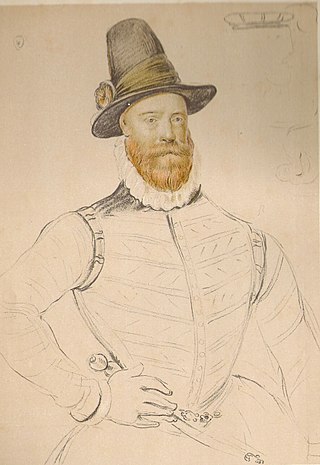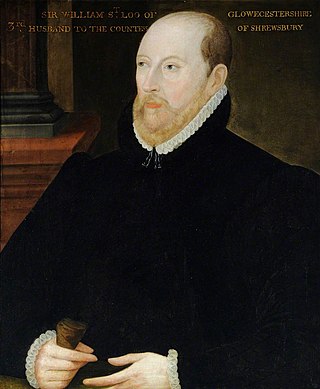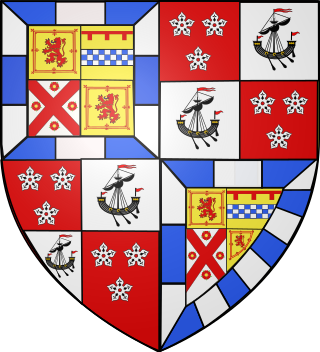Related Research Articles

James V was King of Scotland from 9 September 1513 until his death in 1542. He was crowned on 21 September 1513 at the age of seventeen months. James was the son of King James IV and Margaret Tudor, daughter of Henry VII of England. During his childhood Scotland was governed by regents, firstly by his mother until she remarried, and then by his second cousin, John Stewart, Duke of Albany. James's personal rule began in 1528 when he finally escaped the custody of his stepfather, Archibald Douglas, 6th Earl of Angus. His first action was to exile Angus and confiscate the lands of the Douglases.

James Douglas, 4th Earl of Morton was a Scottish nobleman. He played a leading role in the murders of Queen Mary's confidant, David Rizzio, and king Henry Darnley. He was one of the last of the four regents of Scotland during the minority of James VI and I. He was in some ways the most successful of the four, since he won the civil war that had been dragging on with the supporters of the exiled Mary, Queen of Scots. However, he came to an unfortunate end, executed by means of the Maiden, a predecessor of the guillotine.

The ruins of Linlithgow Palace are located in the town of Linlithgow, West Lothian, Scotland, 15 miles (24 km) west of Edinburgh. The palace was one of the principal residences of the monarchs of Scotland in the 15th and 16th centuries. Although maintained after Scotland's monarchs left for England in 1603, the palace was little used, and was burned out in 1746. It is now a visitor attraction in the care of Historic Environment Scotland.

Matthew Stewart, 4th Earl of Lennox was a leader of the Catholic nobility in Scotland. He was the paternal grandfather of King James VI of Scotland. He owned Temple Newsam in Yorkshire, England.

Archibald Douglas, 6th Earl of Angus was a Scottish nobleman active during the reigns of James V and Mary, Queen of Scots. He was the son of George, Master of Angus, who was killed at the Battle of Flodden, and succeeded as Earl of Angus on the death of his grandfather, Archibald.

James Hamilton, 1st Lord Hamilton, 6th Laird of Cadzow was a Scottish nobleman, scholar and politician.

James Hamilton, 1st Earl of Arran and 2nd Lord Hamilton was a Scottish nobleman, naval commander and first cousin of James IV of Scotland. He also served as the 9th Lord High Admiral of Scotland.

Dumbarton Castle has the longest recorded history of any stronghold in Scotland. It sits on a volcanic plug of basalt known as Dumbarton Rock which is 240 feet (73 m) high and overlooks the Scottish town of Dumbarton.
The skirmish known as Cleanse the Causeway, or Clear the Causeway, took place in the High Street of Edinburgh, Scotland, on 30 April 1520, between rival noblemen James Hamilton, 1st Earl of Arran, chief of Clan Hamilton, and Archibald Douglas, 6th Earl of Angus, chief of Clan Douglas.

Craignethan Castle is a ruined castle in South Lanarkshire, Scotland. It is located above the River Nethan, a tributary of the River Clyde, at NS816464. The castle is two miles west of the village of Crossford, and 4.5 miles north-west of Lanark. Built in the first half of the 16th century, Craignethan is recognised as an excellent early example of a sophisticated artillery fortification, although its defences were never fully tested.
The Battle of Sauchieburn was fought on 11 June 1488, at the side of Sauchie Burn, a stream about two miles (3 km) south of Stirling, Scotland. The battle was fought between the followers of King James III of Scotland and a large group of rebellious Scottish nobles including the future Alexander Home, 2nd Lord Home, who were nominally led by the king's 15-year-old son, James, Duke of Rothesay. James III was killed in the battle, and his son succeeded him as James IV.
John Hamilton, 1st Marquess of Hamilton (1540–1604) was the founder of the long line of the marquesses and dukes of Hamilton in Scotland.

Sir James Hamilton of Finnart was a Scottish nobleman and architect, the illegitimate son of James Hamilton, 1st Earl of Arran, and Marion Boyd of Bonshaw. Although legitimated in 1512 while still a minor, he continued to be known as the "Bastard of Arran". As a key member of the Hamilton family, and second cousin of James V, King of Scotland, he became a prominent member of Scottish society.
John Stewart, 3rd Earl of Lennox was a prominent Scottish magnate. He was the son of Matthew Stewart, 2nd Earl of Lennox and Lady Elizabeth Hamilton, daughter of James Hamilton, 1st Lord Hamilton and Mary Stewart, Princess of Scotland, daughter of King James II of Scotland.

Captain James Stewart, Earl of Arran was created Earl of Arran by the young King James VI, who wrested the title from James Hamilton, 3rd Earl of Arran. He rose to become Lord Chancellor of Scotland and was eventually murdered in 1595.

The Secret Bond was a document drawn up by Cardinal Beaton and signed at Linlithgow by a number of Scottish peers and lairds on 24 July 1543. They agreed to prevent the marriage of Mary, Queen of Scots, to Prince Edward of England. The document is sometimes called the "Linlithgow Bond".

Kinneil House is a historic house to the west of Bo'ness in east-central Scotland. It was once the principal seat of the Hamilton family in the east of Scotland. The house was saved from demolition in 1936 when 16th-century mural paintings were discovered, and it is now in the care of Historic Environment Scotland. The house now consists of a symmetrical mansion built in 1677 on the remains of an earlier 16th- or 15th-century tower house, with two rows of gunloops for early cannon still visible. A smaller east wing, of the mid 16th century, contains the two painted rooms. The house is protected as a Category A listed building.
Sir Thomas Lyon, Master of Glamis was a Scottish nobleman and official, Lord High Treasurer of Scotland.

George Douglas of Pittendreich was a member of the powerful Red Douglas family who struggled for control of the young James V of Scotland in 1528. His second son became James Douglas, 4th Earl of Morton and Regent of Scotland. Initially, George Douglas promoted the marriage of Mary, Queen of Scots and Prince Edward of England. After war was declared between England and Scotland he worked for peace and to increase the power of Mary of Guise, the widow of James V.

The Battle of Melrose was a Scottish clan battle that took place on 25 July 1526. Walter Scott of Branxholme and Buccleuch attempted to rescue the young James V of Scotland from the powerful Archibald Douglas, 6th Earl of Angus.
References
- The Battle of Linlithgow Bridge (archived 2014-05-27)